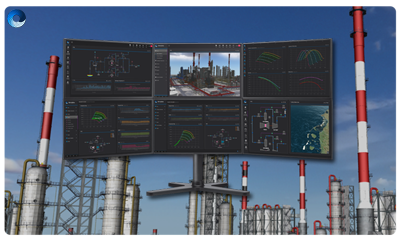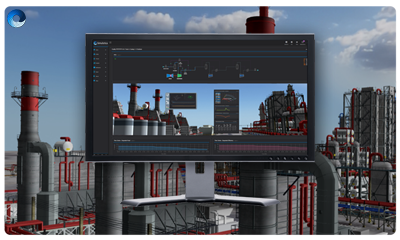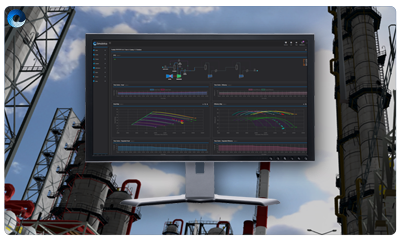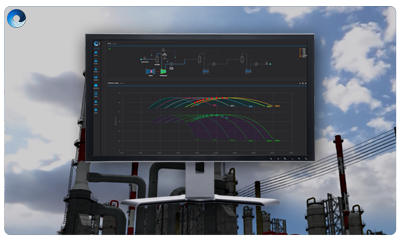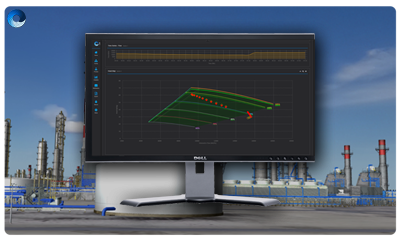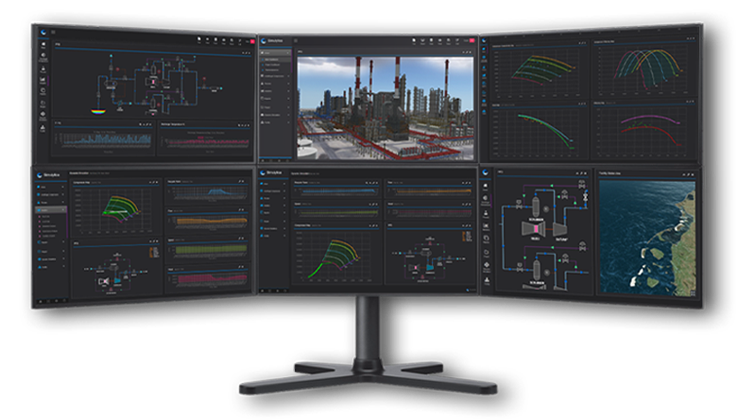
Predictive Performance Analytics
Monitor
Track the performance and condition of machinery and process plant.
Analytics
Determine the causes of performance losses and relate to process conditions.
Predictive
Transform big data into facility productivity maps and investigate “what if” scenarios.
Action Plans
Identify and validate improvement action plans to optimise production rates, OPEX & CAPEX.
Simulytica Performance Analytics
Simulytica provides next generation technologies for monitoring, analysing and simulating the performance and condition of turbomachinery in operating plants across the oil and gas, petrochemical, process and air separation industries.
Simulytica's solutions are web-enabled, featuring proprietary AI and advanced visualisation technologies as well as rigorous and proven analytics engines, including secture data connectivity options to multiple data sources, such as plant data platforms, data APIs, historians, filing systems and databases.
Simulytica's technologies can be easily integrated with any framework, including; third-party platforms, IIoT-enabled devices, ERP systems, installed base and legacy systems, as well as other specialist modelling and simulation applications.
Providing technology to monitor, analyse and predict machinery and plant performance and condition, Simulytica delivers production enhancement by transforming big data into valuable insights and action plans.

Performance & Condition Monitoring
Centrifugal compressors and their drivers are at the heart of oil and gas production facilities, refineries, petrochemical and air separation plants. Their performance has a direct effect on achievable production rates, but this performance cannot be determined from raw plant data alone. Simulytica performs complex thermodynamic calculations and analytics to transform this raw plant data into metrics indicating machinery performance, condition and overall health.
- Connects to machinery and process plant operating data; live or historical.
- Displays machinery and plant operating conditions and health - securely on any device at any location, through state-of the art web-enabled software architecture.
- Provides a full picture via visual engineering components with full trending capability and intuitive dashboards - including 3D representations of compression train performance and condition.
- Fast-tracks analysis and decision making by enabling collaboration between teams in different locations through multi-layered, role-based user accessibility.
- Reduces the number of required visits to normally / frequently unmanned facilities by giving rapid operating data analysis capability in any location.

Analytics
Simulytica’s analytics solution identifies the cause(s) of deteriorations in the performance or condition of turbomachinery. Various proprietary modules apply in-depth thermodynamic and aerodynamic analytics which are augmented by machine learning and artificial intelligence (AI) through Simulytica’s Machine Learning Ready (ML Ready™) technology.
Simulytica’s advanced visualisation systems assist the user in relating the causes of reduced machinery health to potential influences such as process conditions or process plant control.
Simulytica’s analytics elevate the decision-making process by ensuring that action plans, such as expensive compressor overhauls, are based on robust scientific and engineering analysis.

Predictive Analytics
Simulytica Predictive Analytics generates a digital twin to transform data relating to machinery and equipment performance into facility productivity maps. The application of Simulytica’s monitoring and analytics to operating data on an ongoing basis maximises the accuracy of predicted production rates. Simulytica’s predictive analytics allow current operations to be optimised to maximise production, and ensures that this optimisation process can be extended, on an ongoing basis, across the life of the asset.
Simulations can be made with the digital twin to investigate various “what if” scenarios. For example, “if current machinery performance continues, what will be the maximum achievable rate when the temperature increases in the summer months” or “if I reinstate as-new performance via an overhaul, what gas injection manifold pressure will be achievable”?
Teams across the operating company and / or their trusted third-party service providers are empowered by being able to view results collaboratively through a role-based, multi-layered web-enabled user interface, on any computing device or platform – all without the need for software installations. This instant accessibility fast-tracks the decision-making process.

Action Plans
Simulytica’s technology capabilities help in identifing bottlenecks and factors limiting production rates for current conditions. In addition, when coupled with the trending of machinery health and the inclusion of future process requirements, simulations using the digital twin assist the operating company in predicting the advent of future operating limits and bottlenecks. Having highlighted these in advance, Simulytica Predictive Analytics is used to identify, investigate and validate various improvement options.
Assessment metrics are generated so that the option select process may be demonstrated to optimise, for example, production rates, OPEX and CAPEX. This future planning capability ensures that there will be sufficient time to prepare for future works, such as the time required to purchase a compressor rewheel and plan its installation.
Simulytica’s digital twin with its rigorous thermodynamic and aerodynamic modelling of machinery utilising actual plant performances greatly increases the confidence with which facility improvement action plans can be developed, investigated and validated.

